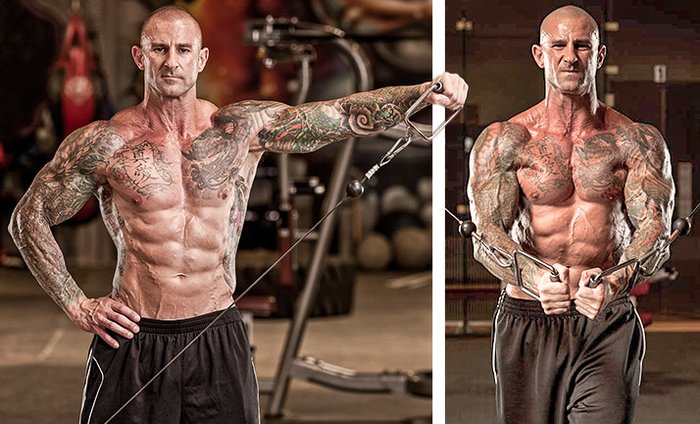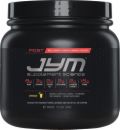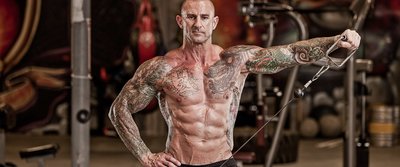If you noticed those three little letters after my name, it should come as no surprise to you that I think science is cool. After all, I am a scientist.
But I don't mean cool in a "geek is cool" kind of way. I mean it in a hardcore, bad-ass, bodybuilding way.
Bodybuilding is science. How do muscles grow? Science. How do I increase strength? Science. How do I strip body fat? Science.
Science allows me to maintain a body weight of 220 pounds and a body-fat level of 5 percent year-round without the use of drugs. I rely on science when I need to drop my body fat to under 5 percent and squeeze out every ounce of muscle-blurring water from under my skin to get that ultra-ripped look.
Now it's your turn. Maybe you're getting ready for a bodybuilding or fitness competition. Maybe you have an upcoming photo shoot. Or maybe you're going on a beach vacation and want to look ripped when you shed your clothes.
Whatever the reason, my seven scientific steps will help you reach your physical peak for what we refer to as "peak day."

"How do muscles grow? Science. How do I increase strength? Science. How do I strip body fat? Science."
Step 1. Load Up on Sodium
About two weeks out from peak day, start loading up on sodium (aka salt). How much water your body holds is closely related to how much sodium it holds. However, your body will only hold so much water, regardless of how much sodium you consume.
When you first increase sodium levels, your body will hold more water. But after maintaining high sodium levels for several days, your body will adapt and end up holding about the same amount of water as when your sodium intake was low.
This step will help you shed more water when you finally cut your sodium intake. More on that in step four.
How To Do It
Increase sodium levels by choosing higher-sodium foods and, of course, salt your food. While there's no precise daily dose of sodium to hit, shoot for at least 3,000-4,000 milligrams per day.
Note: Protein sources like cottage cheese, low-fat cheeses, lean deli meats, sardines, anchovies, canned tuna, and chicken, are good sources of sodium. Other sources of extra sodium include canned and jarred vegetables.
Step 2. Drop the Carbs
If you're serious about looking your best, you should already be eating a low-carbohydrate diet of around 1/2 gram per pound of body weight per day leading up to the peak date.
However, one week before peak day, it's time to really cut carbs in an effort to deplete your body's glycogen levels. Glycogen is the storage form of carbs in your body. Whether it's the starch from bread and potatoes or the sugars in fruits and candies, your body converts these carbs into glucose.
Glucose can be burned for immediate fuel, but it can also be stored in muscles and the liver for later use. To store glucose, the body connects glucose molecules into a long chain called glycogen.

"If you're serious about looking your best, you should already be eating a low-carbohydrate diet of around ½ gram per pound of body weight per day leading up to the peak date."
Dropping carbs to as few as possible serves two purposes:
- The more immediate effect is to ramp up fat burning. When you consume no carbs, your body is forced to turn to body fat as a major fuel source. This will help burn off those last few pounds of body fat, leaving you that much leaner.
- The other effect of dropping carbs to nil has on your body is that it depletes your body's glycogen stores. Glycogen stored in muscle holds water; it literally pulls water into the muscle, filling it up much like a water balloon. The more glycogen you store in your muscles, the more water is pulled in and the bigger your muscles blow up.
- So why do you want to deplete glycogen? It's actually in an effort to store more glycogen when you carb load later in the week. Research has discovered that When you deplete muscle glycogen levels and then carb load, your muscles are able to store significantly more glycogen than normal. More on this is Step 6.
How To Do It
On days 7, 6, and 5 before the peak date, eat only protein and small servings of vegetables (about 1 cup) for meals. The only time you'll be allowed real carbs is immediately after workouts with your post-workout protein shake.
Then you can have 20-30 grams of carbs, preferably fast-digesting, such as dextrose (as in Post JYM, Wonka Pixy Stix, Wonka Sweet Tarts, gummy bears, sorbet, or angel food cake0.
On days 4 and 3 before peak day, you'll need to drop even the post-workout carbs to fully deplete glycogen levels.
If you're using Post JYM—and you should be—you can nix the extra dextrose. This is why I kept the carbs in Post JYM separate from the active-matrix ingredients.
Note: Be sure you are working out, both with weights and cardio every day during days 7 to 3 before the peak day. It's also a good idea to do a whole-body workout, using high reps (15-20) and minimal rest (30-60 seconds) between sets on day 3 before the peak day. This is essential for depleting muscle glycogen levels.

Step 3. Keep Taking Creatine Hydrochloride

"Most people worry about taking creatine when trying to peak, due to potential bloating—which can blur muscle definition."
With carbs nearly absent during the final week, you'll need a solid energy source to power you through workouts. It's critical to keep intensity levels high during workouts to burn up stored glycogen. Creatine is a great energy source during workouts. Few people realize that creatine's main function in the muscle is as a quick source of energy.
When you're banging out reps, your muscles need ample amounts of energy in the form of ATP to keep contracting. In simple terms, creatine provides the energy needed to make ATP quickly.
Most people worry about taking creatine when trying to peak, due to potential bloating—which can blur muscle definition. After all, creatine attracts water. While the water that creatine pulls inside the muscles is a good thing for keeping muscles full, any creatine sitting outside the muscles will pull more water there, too. And that leads to more water being retained under the skin, which can lead to a bloated, water-retained look.
While creatine monohydrate has been shown to increase water levels outside the muscle (under the skin) as well as inside, creatine hydrochloride (HCL) appears to not draw water under the skin. One study found that subjects taking creatine HCL absorbed significantly more creatine into their bloodstream than when they took monohydrate. Althought the study did not measure creatine uptake into the muscle fibers, it's likely that creatine HCL also gets taken up into muscle cells better than creatine monohydrate.
My own experience with creatine HCL and the thousands—if not millions—of people who have switched from creatine monohydrate to creatine HCL on my advice, suggests this is the case, based on the significantly greater gains in muscle size and strength realized with creatine HCL.
Because creatine HCL is better taken up into the muscle, none is left sitting around outside the muscle to cause water retention under the skin. The proof is in the photos. I take 2 grams of creatine HCL before and after every workout via Pre JYM and Post JYM, during the final week before my peak day. And as you can see from my photos, I'm not retaining any water under my skin.
How To Do It
Take 2 grams of creatine HCL before and after every workout (including cardio workouts). Your best method of getting this creatine HCL is through Pre JYM and Post JYM.
Step 4. Drop the Sodium
One week before peak day, it's time to cut as much sodium as humanly possible. Now that your body water levels have adjusted to a higher sodium intake of several grams per day, dropping sodium levels to just hundreds of milligrams will purge all the excess water from your body.
How To Do It
On day 7 before peak day, keep sodium under 2,000 mg. On day 6, stay under 1,000 mg. On days 5, 4, and 3, stay under 600 mg. And on days 2 and 1 before peak day, try to keep sodium as far below 500 mg as possible.
Note: Read labels on EVERYTHING you eat or drink. Meats, such as chicken breast, beef, and fish, provide about 60-80 mg of sodium per 3 ounces. This should be one of your only sodium sources. However, read the labels on the meats you're purchasing to make sure no sodium or saline is added.
A lot of chicken is injected with sodium solutions. Only buy chicken, meat, or fish that lists sodium content on the label. Don't use any sauces or marinades; these will almost always include sodium. Even read the ingredients of any spices to make sure no salt is included.

"Only buy chicken, meat, or fish that lists sodium content on the label."
Eggs and protein powders are two unexpected sources of sodium. One whole egg only provides 5 grams of protein but 65 mg of sodium. That's the same amount of sodium in 3 oz of chicken or beef, which provide 20 or more grams of protein. The protein-to-sodium ratio of eggs makes them less than ideal during this final week.
Many protein powders, especially whey protein, contain almost 200 mg of sodium per scoop (about 20 grams of protein). Stick with protein powders with fewer than 100 mg of sodium per scoop, such as Dymatize's Elite Casein (35 mg per scoop) and Elite Gourmet Protein (75 mg per scoop).
Only eat fresh vegetables to keep sodium levels down. Do NOT eat any cooked food out at restaurants. There is no way to tell how the food was stored or cooked, which likely included sodium. The only food that's safe to eat at a restaurant is sashimi.
Step 5. Drink Water
One week from the peak day, it's time to drink a LOT of water. This will flush out any remaining sodium in your body, making all that water you're drinking work to rid your body of excess water. It sounds counterintuitive, but it works!
How To Do It
Shoot to drink 1 ½ to 2 gallons of water per day.
Note: Instead of counting every glass of water you drink, an easy way to make sure you're hitting your 1½ to 2 gallon mark is to buy gallon jugs of water. I find that drinking water from larger containers also makes it much easier to consume so much water.
Somehow it seems less daunting to drink two 1-gallon containers than 30 8-ounce glasses.
Step 6. Cut Water
The last two days before the peak day, you'll need to limit your fluid intake. As I mentioned, the amount of water your body holds is closely related to the amount of sodium your body holds.
Since you're now limiting sodium and guzzling water like a fish, you have only a few days before your body adjusts to the low sodium levels and starts to hold more water despite the low sodium intake. To avoid this, you will need to sharply cut back on water the last two days before the peak day.
How To Do It
On day 2 before the peak date, keep water intake under ½ gallon. On day 1 before the peak day, limit water intake to less than 20 ounces. On the peak date you can drink water, but do so slowly.
Watch how your body responds to small sips throughout the day. If your hardness starts blurring from water intake, stop drinking.
Note: To keep dropping body water despite taking in very little water, consider using natural diuretics such as Arctostaphylos uva ursi (bearberry) and Taraxacum officianale (dandelion).
Caution: Dehydrating your body can be very dangerous. If you experience severe headaches, dizziness, nausea, weakness, servere muscle cramps, or your urine color turns a brown or greenish brown, start drinking more water immediately.
Step 7. Carb Load
Two days before the peak date it's time to restock, er, overstock your muscle glycogen levels. You not only want to look as shredded as possible on the peak day, but you also want to look as big and as muscular as possible.
As I explained earlier under Step 2, going for several days on little-to-no carbs depletes muscle glycogen levels. And that allows your muscles to store significantly more glycogen than they normally could.
Since glycogen pulls water into the muscles, this works to fill up your muscles like water balloons, not only helping you to look bigger but also helping you get more shredded. As you fill your muscles with glycogen, they pull water into the muscle.
A good deal of that water will come from under the skin. So by carb loading in these last few days, you're not only helping your body to look bigger and fuller but also helping your body get that ultra-shredded look.
How To Do It
The first 24 hours is the most critical time window for carb loading. So be sure to pound as many carbs as possible. Shoot for 3-4 grams of carbs per pound of body weight.
Note: Carbs can come from fast-digesting sources, such as fat-free candy and white potatoes; or from slower-digesting sources such as sweet potatoes or yams. If you think oatmeal, rice, or pasta are good carb sources, think again.
Remember, you are limiting water intake and these carb sources are made with water, which these carbs absorb. You need carb sources that are as dry as possible. You also need carb sources that provide zero milligrams of sodium.

"Remember, you are limiting water intake and these carb sources are made with water, which these carbs absorb."
You'll be getting sodium from your protein sources, so be sure that your carb sources are not a source of unwanted sodium. Be sure to read all labels carefully. Besides potatoes (be sure to bake them and not boil them), good dry and sodium-free carbs include Wonka Pixy Stix, Wonka Sweet Tarts, certain flavors of Bear Naked Granola, and air-popped popcorn that you make yourself.
You can also eat some fruit during the first day of carbing up. But it needs to be freeze-dried and sodium free. During the second day of carb loading I would suggest forgoing any type of fruit. The reason is that fruit contains fructose. One problem with fructose is that the body does not use it well.
The majority of fructose you eat gets converted to glucose by the liver. However, if the liver is stocked with glycogen, it will convert fructose into fat instead.
That's the last thing you want. During the first day of carb loading, your liver and muscles are not stocked up with glycogen, so any fructose you consume will be converted to glucose. But on the second day of carb loading, there's a bigger risk of converting fructose into fat since the liver becomes stocked with glycogen.
This is another reason why I recommend that you stick with Wonka Pixy Stix and Wonka Sweet Tarts. Most candy companies use sugar (which is half glucose and half fructose), or high fructose corn syrup, which has even more fructose. Yet Wonka Pixy Stix are pure dextrose (glucose) and Sweet Tarts are made with just dextrose and maltodextrin (which is simply a chain of glucose molecules attached together.
These are one of the few candies that you can buy that contains no fructose.
So your six-pack is now ready for your big photo shoot. Are YOU?

